Input interpretation

H_2SO_4 (sulfuric acid) + HBr (hydrogen bromide) ⟶ H_2O (water) + SO_2 (sulfur dioxide) + Br_2 (bromine)
Balanced equation
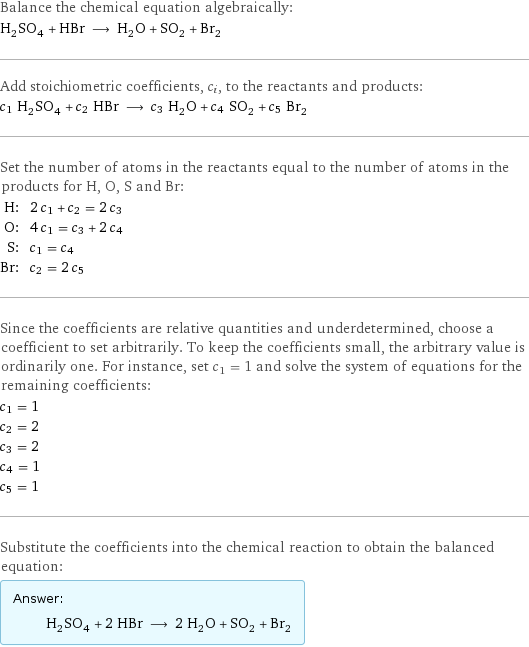
Balance the chemical equation algebraically: H_2SO_4 + HBr ⟶ H_2O + SO_2 + Br_2 Add stoichiometric coefficients, c_i, to the reactants and products: c_1 H_2SO_4 + c_2 HBr ⟶ c_3 H_2O + c_4 SO_2 + c_5 Br_2 Set the number of atoms in the reactants equal to the number of atoms in the products for H, O, S and Br: H: | 2 c_1 + c_2 = 2 c_3 O: | 4 c_1 = c_3 + 2 c_4 S: | c_1 = c_4 Br: | c_2 = 2 c_5 Since the coefficients are relative quantities and underdetermined, choose a coefficient to set arbitrarily. To keep the coefficients small, the arbitrary value is ordinarily one. For instance, set c_1 = 1 and solve the system of equations for the remaining coefficients: c_1 = 1 c_2 = 2 c_3 = 2 c_4 = 1 c_5 = 1 Substitute the coefficients into the chemical reaction to obtain the balanced equation: Answer: | | H_2SO_4 + 2 HBr ⟶ 2 H_2O + SO_2 + Br_2
Structures

+ ⟶ + +
Names

sulfuric acid + hydrogen bromide ⟶ water + sulfur dioxide + bromine
Reaction thermodynamics
Enthalpy
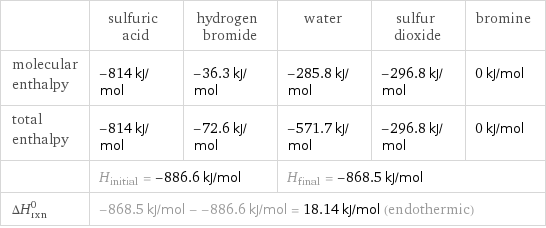
| sulfuric acid | hydrogen bromide | water | sulfur dioxide | bromine molecular enthalpy | -814 kJ/mol | -36.3 kJ/mol | -285.8 kJ/mol | -296.8 kJ/mol | 0 kJ/mol total enthalpy | -814 kJ/mol | -72.6 kJ/mol | -571.7 kJ/mol | -296.8 kJ/mol | 0 kJ/mol | H_initial = -886.6 kJ/mol | | H_final = -868.5 kJ/mol | | ΔH_rxn^0 | -868.5 kJ/mol - -886.6 kJ/mol = 18.14 kJ/mol (endothermic) | | | |
Gibbs free energy
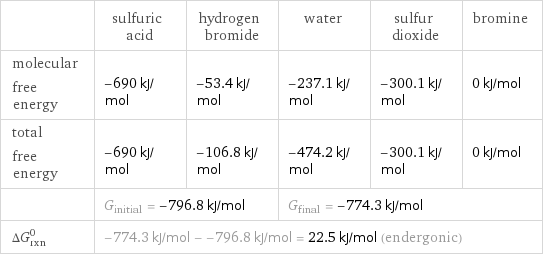
| sulfuric acid | hydrogen bromide | water | sulfur dioxide | bromine molecular free energy | -690 kJ/mol | -53.4 kJ/mol | -237.1 kJ/mol | -300.1 kJ/mol | 0 kJ/mol total free energy | -690 kJ/mol | -106.8 kJ/mol | -474.2 kJ/mol | -300.1 kJ/mol | 0 kJ/mol | G_initial = -796.8 kJ/mol | | G_final = -774.3 kJ/mol | | ΔG_rxn^0 | -774.3 kJ/mol - -796.8 kJ/mol = 22.5 kJ/mol (endergonic) | | | |
Entropy
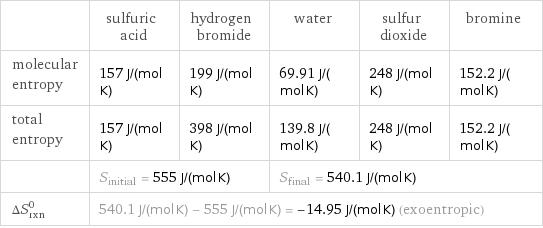
| sulfuric acid | hydrogen bromide | water | sulfur dioxide | bromine molecular entropy | 157 J/(mol K) | 199 J/(mol K) | 69.91 J/(mol K) | 248 J/(mol K) | 152.2 J/(mol K) total entropy | 157 J/(mol K) | 398 J/(mol K) | 139.8 J/(mol K) | 248 J/(mol K) | 152.2 J/(mol K) | S_initial = 555 J/(mol K) | | S_final = 540.1 J/(mol K) | | ΔS_rxn^0 | 540.1 J/(mol K) - 555 J/(mol K) = -14.95 J/(mol K) (exoentropic) | | | |
Equilibrium constant
![Construct the equilibrium constant, K, expression for: H_2SO_4 + HBr ⟶ H_2O + SO_2 + Br_2 Plan: • Balance the chemical equation. • Determine the stoichiometric numbers. • Assemble the activity expression for each chemical species. • Use the activity expressions to build the equilibrium constant expression. Write the balanced chemical equation: H_2SO_4 + 2 HBr ⟶ 2 H_2O + SO_2 + Br_2 Assign stoichiometric numbers, ν_i, using the stoichiometric coefficients, c_i, from the balanced chemical equation in the following manner: ν_i = -c_i for reactants and ν_i = c_i for products: chemical species | c_i | ν_i H_2SO_4 | 1 | -1 HBr | 2 | -2 H_2O | 2 | 2 SO_2 | 1 | 1 Br_2 | 1 | 1 Assemble the activity expressions accounting for the state of matter and ν_i: chemical species | c_i | ν_i | activity expression H_2SO_4 | 1 | -1 | ([H2SO4])^(-1) HBr | 2 | -2 | ([HBr])^(-2) H_2O | 2 | 2 | ([H2O])^2 SO_2 | 1 | 1 | [SO2] Br_2 | 1 | 1 | [Br2] The equilibrium constant symbol in the concentration basis is: K_c Mulitply the activity expressions to arrive at the K_c expression: Answer: | | K_c = ([H2SO4])^(-1) ([HBr])^(-2) ([H2O])^2 [SO2] [Br2] = (([H2O])^2 [SO2] [Br2])/([H2SO4] ([HBr])^2)](../image_source/3f0e25c5e57505b71b2889f1902e43c4.png)
Construct the equilibrium constant, K, expression for: H_2SO_4 + HBr ⟶ H_2O + SO_2 + Br_2 Plan: • Balance the chemical equation. • Determine the stoichiometric numbers. • Assemble the activity expression for each chemical species. • Use the activity expressions to build the equilibrium constant expression. Write the balanced chemical equation: H_2SO_4 + 2 HBr ⟶ 2 H_2O + SO_2 + Br_2 Assign stoichiometric numbers, ν_i, using the stoichiometric coefficients, c_i, from the balanced chemical equation in the following manner: ν_i = -c_i for reactants and ν_i = c_i for products: chemical species | c_i | ν_i H_2SO_4 | 1 | -1 HBr | 2 | -2 H_2O | 2 | 2 SO_2 | 1 | 1 Br_2 | 1 | 1 Assemble the activity expressions accounting for the state of matter and ν_i: chemical species | c_i | ν_i | activity expression H_2SO_4 | 1 | -1 | ([H2SO4])^(-1) HBr | 2 | -2 | ([HBr])^(-2) H_2O | 2 | 2 | ([H2O])^2 SO_2 | 1 | 1 | [SO2] Br_2 | 1 | 1 | [Br2] The equilibrium constant symbol in the concentration basis is: K_c Mulitply the activity expressions to arrive at the K_c expression: Answer: | | K_c = ([H2SO4])^(-1) ([HBr])^(-2) ([H2O])^2 [SO2] [Br2] = (([H2O])^2 [SO2] [Br2])/([H2SO4] ([HBr])^2)
Rate of reaction
![Construct the rate of reaction expression for: H_2SO_4 + HBr ⟶ H_2O + SO_2 + Br_2 Plan: • Balance the chemical equation. • Determine the stoichiometric numbers. • Assemble the rate term for each chemical species. • Write the rate of reaction expression. Write the balanced chemical equation: H_2SO_4 + 2 HBr ⟶ 2 H_2O + SO_2 + Br_2 Assign stoichiometric numbers, ν_i, using the stoichiometric coefficients, c_i, from the balanced chemical equation in the following manner: ν_i = -c_i for reactants and ν_i = c_i for products: chemical species | c_i | ν_i H_2SO_4 | 1 | -1 HBr | 2 | -2 H_2O | 2 | 2 SO_2 | 1 | 1 Br_2 | 1 | 1 The rate term for each chemical species, B_i, is 1/ν_i(Δ[B_i])/(Δt) where [B_i] is the amount concentration and t is time: chemical species | c_i | ν_i | rate term H_2SO_4 | 1 | -1 | -(Δ[H2SO4])/(Δt) HBr | 2 | -2 | -1/2 (Δ[HBr])/(Δt) H_2O | 2 | 2 | 1/2 (Δ[H2O])/(Δt) SO_2 | 1 | 1 | (Δ[SO2])/(Δt) Br_2 | 1 | 1 | (Δ[Br2])/(Δt) (for infinitesimal rate of change, replace Δ with d) Set the rate terms equal to each other to arrive at the rate expression: Answer: | | rate = -(Δ[H2SO4])/(Δt) = -1/2 (Δ[HBr])/(Δt) = 1/2 (Δ[H2O])/(Δt) = (Δ[SO2])/(Δt) = (Δ[Br2])/(Δt) (assuming constant volume and no accumulation of intermediates or side products)](../image_source/0da3d089144cd5608fca1c12739f1ac2.png)
Construct the rate of reaction expression for: H_2SO_4 + HBr ⟶ H_2O + SO_2 + Br_2 Plan: • Balance the chemical equation. • Determine the stoichiometric numbers. • Assemble the rate term for each chemical species. • Write the rate of reaction expression. Write the balanced chemical equation: H_2SO_4 + 2 HBr ⟶ 2 H_2O + SO_2 + Br_2 Assign stoichiometric numbers, ν_i, using the stoichiometric coefficients, c_i, from the balanced chemical equation in the following manner: ν_i = -c_i for reactants and ν_i = c_i for products: chemical species | c_i | ν_i H_2SO_4 | 1 | -1 HBr | 2 | -2 H_2O | 2 | 2 SO_2 | 1 | 1 Br_2 | 1 | 1 The rate term for each chemical species, B_i, is 1/ν_i(Δ[B_i])/(Δt) where [B_i] is the amount concentration and t is time: chemical species | c_i | ν_i | rate term H_2SO_4 | 1 | -1 | -(Δ[H2SO4])/(Δt) HBr | 2 | -2 | -1/2 (Δ[HBr])/(Δt) H_2O | 2 | 2 | 1/2 (Δ[H2O])/(Δt) SO_2 | 1 | 1 | (Δ[SO2])/(Δt) Br_2 | 1 | 1 | (Δ[Br2])/(Δt) (for infinitesimal rate of change, replace Δ with d) Set the rate terms equal to each other to arrive at the rate expression: Answer: | | rate = -(Δ[H2SO4])/(Δt) = -1/2 (Δ[HBr])/(Δt) = 1/2 (Δ[H2O])/(Δt) = (Δ[SO2])/(Δt) = (Δ[Br2])/(Δt) (assuming constant volume and no accumulation of intermediates or side products)
Chemical names and formulas
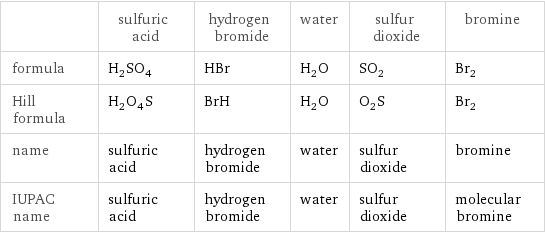
| sulfuric acid | hydrogen bromide | water | sulfur dioxide | bromine formula | H_2SO_4 | HBr | H_2O | SO_2 | Br_2 Hill formula | H_2O_4S | BrH | H_2O | O_2S | Br_2 name | sulfuric acid | hydrogen bromide | water | sulfur dioxide | bromine IUPAC name | sulfuric acid | hydrogen bromide | water | sulfur dioxide | molecular bromine